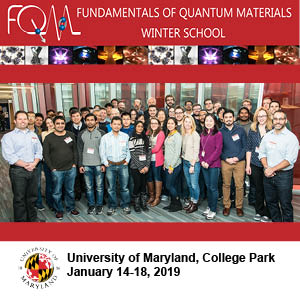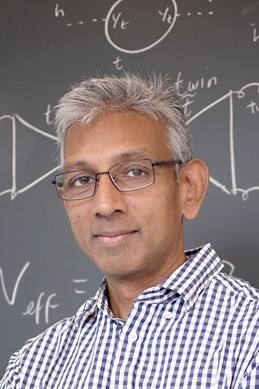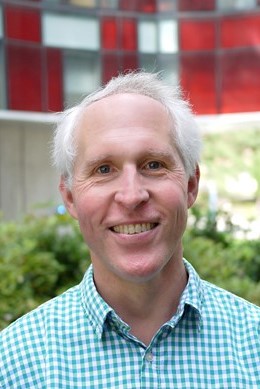Christopher Monroe Quoted in Gizmodo Article on IBM's New Quantum Computer
- Details
- Published: Thursday, January 10 2019 09:33
 The University of Maryland Department of Physics will host the third annual Fundamentals of Quantum Materials Winter School and Workshop January 14th to the 18th at the University of Maryland.
The University of Maryland Department of Physics will host the third annual Fundamentals of Quantum Materials Winter School and Workshop January 14th to the 18th at the University of Maryland.
The Fundamentals of Quantum Materials Winter School and Workshop is an annual event unique to North America, dedicated specifically to the synthesis, characterization and electronic modeling of quantum materials. The FQM Winter School is aimed at providing fundamental training to our current and future generations of Quantum Materials scientists in synthesis and characterization techniques, bringing together senior and junior scientists to address topics at the forefront of current research into quantum materials, while also providing pedagogical background and practical training for junior scientists. With an interdisciplinary and diverse crowd including physicists, chemists, and materials scientists, participants gain a basic functional knowledge of how to plan and carry out synthesis relevant to the study of quantum materials, and experience a unique opportunity to interact with some of the top researchers in the field while networking with fellow peers. The structure of the school includes mornings of pedagogical lectures by ten of the nation's top practicing quantum materials scientists, with afternoons devoted to practical demonstrations in laboratories in the University of Maryland's Center for Nanophysics and Advanced Materials. The school also includes a poster session attended by senior scientists. The FQM Workshop, following the school event, covers current top research on quantum materials, focusing on synthesis, characterization and computational approaches to research of quantum materials such as superconductors, strongly correlated electron systems and topological materials.
For more information, visit the Fundamentals of Quantum Materials Winter School and Workshop homepage.
Sankar Das Sarma and Ian Spielman join six other faculty members in the University of Maryland’s College of Computer, Mathematical, and Natural Sciences included on Clarivate Analytics’ 2018 list of Highly Cited Researchers, a compilation of influential names in science.
Sankar Das Sarma is a Richard E. Prange Chair and Distinguished University Professor in Physics, Joint Quantum Institute Fellow, and Condensed Matter Theory Center Director. Das Sarma was included in all previous compilations of this list in 2017, 2016, 2015, 2014 and 2001.
Ian Spielman is an Adjunct Professor of Physics, JQI Fellow and National Institute of Standards and Technology (NIST) Fellow. Spielman was also included in the 2017 compilation.
 Raman Sundrum. Photo: Faye Levine
Raman Sundrum. Photo: Faye Levine
The American Physical Society awarded its 2019 J.J. Sakurai Prize for Theoretical Particle Physics to Raman Sundrum, a Distinguished University Professor of Physics at the University of Maryland. Sundrum’s collaborator on two key papers, Harvard University Physics Professor Lisa Randall, also received the award.
Sundrum and Randall were honored for making a number of theoretical predictions that set off a wave of experiments searching for theoretical subatomic particles—experiments that are still active today, almost two decades later.
“As a theoretical physicist, I always hope my ideas are ultimately connected to experiments that examine the nature of reality,” said Sundrum, who also holds the John S. Toll Chair in Physics and directs the Maryland Center for Fundamental Physics. “It’s very meaningful to me that this prize was awarded for motivating experimental searches for new particles.”
Sundrum studies theoretical particle physics, which seeks to understand the subatomic particles that make up the world around us. The laws of physics—the laws of quantum mechanics, in particular—strongly suggest that such particles should be far heavier than physicists have observed them to be. This disparity is nicknamed the “hierarchy puzzle.”
In 1999, Sundrum and Randall published two papers in the journal Physical Review Letters that have been cited nearly 20,000 times in all. Their work proposed an extra dimension of space that is capable of distorting, or warping, space and time as a solution to the puzzle. People do not experience this dimension because unlike the three dimensions of space, which go on forever, this dimension is highly limited: it is more like an extradimensional, subatomic “bubble.”
However, this dimension can affect particles. In particular, it can dramatically change the mass of particles, making the “true” mass of the particle match the mass predicted by quantum mechanics.
Sundrum and Randall’s work, which became known as the Randall-Sundrum models, makes a number of other predictions. In particular, it predicts the existence of new types of gravitons, which are theoretical particles that carry the force of gravity. This prediction inspired experiments to look for gravitons using the Large Hadron Collider (LHC), the world’s largest particle accelerator located at CERN near Geneva, Switzerland.
“These gravitons would be microscopic gravitational waves bouncing around the extra dimension, so you need a big magnifying glass, which is what the LHC is,” Sundrum said. “Our work has also inspired experiments to search for all kinds of other particles that might exist in the extra dimension. It continues to be an active area of study.”
Sundrum learned about theoretical particle physics as an undergraduate student at the University of Sydney in Australia.
“One day, I came upon a Scientific American article about particle physics,” Sundrum said. “I didn’t even know there was such a thing until I saw that article, but I found the subject so interesting that I decided to study it.”
After receiving his B.S. in mathematics and physics from the University of Sydney in 1984, Sundrum studied elementary particle theory at Yale University, where he received his Ph.D. in 1990. He then took several postdoctoral positions, including one at Boston University from 1996 to 1999.
At Boston University, he studied “dark energy,” a theoretical form of energy that permeates the universe. Sundrum published a number of papers that tackled the topic using extra dimensions. These papers caught the attention of Randall, who invited Sundrum to collaborate. While they did not solve the mysteries of dark energy, their results turned out to be applicable to the hierarchy problem.
“Our finding was completely unexpected,” Sundrum said. “I threw myself at the problem of dark energy and failed, but my failure spun off into a solution for the hierarchy problem.”
After taking a faculty position at the Johns Hopkins University, Sundrum came to UMD in 2010, where he continues to study particle physics in extra dimensions and other topics. Today, he is especially interested in warped extra dimensions as a source of macroscopic gravitational waves—such as those detected by the Laser Interferometer Gravitational-Wave Observatory (LIGO).
In 2018, Sundrum and three colleagues from the Maryland Center for Fundamental Physics—Michael Geller, Anson Hook and Yuhsin Tsai—wrote a paper that is accepted for publication in the journal Physical Review Letters proposing to study the gravitational wave background. Unlike gravitational wave signals from black hole or neutron star mergers, signals from the gravitational wave background can originate from collisions between extradimensional bubbles in the very early universe. These extradimensional bubbles are related to the “bubbles” that make it possible to theoretically solve the hierarchy problem and can potentially teach scientists about the early universe.
“Our study showed that gravitational wave background signals should not be evenly spread across the entire universe, but would rather have hot spots and cold spots,” Sundrum said. “Importantly, the pattern of the hot spots could tell us about how the universe was operating at the very beginning, possibly even before the Big Bang.”
###
The paper, “Primordial Anisotropies in the Gravitational Wave Background from Cosmological Phase Transitions,” Michael Geller, Anson Hook, Raman Sundrum and Yuhsin Tsai, is forthcoming in the journal Physical Review Letters.
The paper, “An Alternative to Compactification,” Lisa Randall and Raman Sundrum, was published in the journal Physical Review Letters on December 6, 1999.
The paper, “Large Mass Hierarchy from a Small Extra Dimension,” Lisa Randall and Raman Sundrum, was published in the journal Physical Review Letters on October 25, 1999.
Media Relations Contact: Irene Ying, 301-405-5204, This email address is being protected from spambots. You need JavaScript enabled to view it.
For a full listing of 2019 APS Award Recipients visit: http://www.aps.org/programs/honors/new-recipients.cfm
 Christopher Jarzynski. Photo: Faye Levine The American Physical Society awarded its 2019 Lars Onsager Prize in Theoretical Statistical Physics, to Chris Jarzynski, a Distinguished University Professor in the University of Maryland’s Department of Chemistry and Biochemistry, Department of Physics, and Institute for Physical Science and Technology (IPST). Jarzynski will receive the prize, which recognizes outstanding research in theoretical statistical physics, at the society’s March Meeting 2019 in Boston.
Christopher Jarzynski. Photo: Faye Levine The American Physical Society awarded its 2019 Lars Onsager Prize in Theoretical Statistical Physics, to Chris Jarzynski, a Distinguished University Professor in the University of Maryland’s Department of Chemistry and Biochemistry, Department of Physics, and Institute for Physical Science and Technology (IPST). Jarzynski will receive the prize, which recognizes outstanding research in theoretical statistical physics, at the society’s March Meeting 2019 in Boston.
“This particular award is very special to me because it’s named after Onsager, who was a real giant in theoretical statistical physics and is viewed as a founder of nonequilibrium statistical physics—the field that I work in,” Jarzynski said.
The award also demonstrates UMD’s strength in statistical physics, as the first Lars Onsager Prize was awarded in 1995 to Michael Fisher, a Distinguished University Professor Emeritus in IPST.
Statistical physicists use the tools of mathematics and statistics to investigate how atoms and molecules physically behave at extremely small scales, such as in quantum systems. More specifically, Jarzynski analyzes artificial molecular machines, develops efficient ways to compute the thermodynamic properties of complex systems and applies statistical physics to problems in biophysics.
“Because my work lies on the border of chemistry and physics, it’s been really helpful for me to be at an institute where there are other people with interdisciplinary interests,” said Jarzynski, who is also director of IPST. “IPST brings together really wonderful colleagues who are generous with their time and effort.”
In May 2018, Jarzynski co-authored a study published in the journal Nature Physics that devised and demonstrated a new way to measure “free energy”—the energy available to any system to perform useful work—in extremely small systems. By using microscopy to track and analyze the fluctuating motion or configuration of single molecules or other small objects, the new method can be applied to a greater variety of systems than previous techniques.
Going forward, Jarzynski plans to conduct research at the intersection of statistical mechanics—using probability and statistics to model the behavior of particles—and quantum physics. He will examine the fundamental constraints that the laws of thermodynamics place on information processing in quantum systems as well as investigate how to control and manipulate quantum systems.
Of the nearly 100 papers that Jarzynski has published, the most cited is a 1997 paper published in the journal Physical Review Letters. In this paper, Jarzynski described a method of expressing the second law of thermodynamics—which states that the level of disorder in the universe can only increase—for systems at the molecular scale.
“That was my very first paper in statistical physics,” said Jarzynski, who wrote and submitted the sole-author paper while a research associate at the Institute for Nuclear Theory based at the University of Washington. “After I published that result, I came up with further questions and I’ve stayed in that field for the last 20 years.”
The paper proved influential for the field of statistical physics: thousands of papers cite it and an equation in the paper became known as the Jarzynski equality.
“At first, there was some question of whether my paper was just a theoretical prediction,” Jarzynski said. “But a few years later, experiments started verifying my work.”
Then, when the 2018 Nobel Prize in physics was awarded for inventions in laser physics, the Nobel Committee for Physics specifically cited testing the Jarzynski equality as an application of one of the winning inventions—optical tweezers. Optical tweezers use laser beams to manipulate extremely small objects such as biological molecules.
The equality has now been verified in many systems, including quantum mechanical systems. In 2014, scientists helped verify the Jarzynski equality with a trapped ion system and published the results in the journal Nature Physics. The study’s authors included two former UMD postdocs—Kihwan Kim, an associate professor in the Institute for Interdisciplinary Information Sciences at Tsinghua University in Beijing, and Haitao Quan, an assistant professor of physics at Beijing’s Peking University.
The opportunity to recruit postdocs like Quan and promising graduate students to his lab was a key reason that Jarzynski moved to UMD in 2006 from the Los Alamos National Laboratory, where he worked for the preceding decade.
“The thing I’m most proud of here at Maryland is having built my own research group,” Jarzynski said. “I’ve been very fortunate in having terrific students and postdocs, many of whom are now in academic positions.”
One of those students will also be honored at the March Meeting alongside Jarzynski. Jordan Horowitz (Ph.D. ’10, physics), who is now a postdoctoral fellow in physics at the Massachusetts Institute of Technology and will soon start a position as an assistant professor at the University of Michigan, will receive the Irwin Oppenheim Award, which recognizes outstanding contributions to physics by early career scientists who publish in the journal Physical Review E.
###
The paper, “Equilibrium free energies from non-equilibrium trajectories with relaxation fluctuation spectroscopy,” David Ross, Elizabeth Strychalski, Christopher Jarzynski and Samuel Stavis, was published in the journal Nature Physics on May 28, 2018.
The paper, “Experimental test of the quantum Jarzynski equality with a trapped-ion system,” Shuoming An, Jing-Ning Zhang, Mark Um, Dingshun Lv, Yao Lu, Junhua Zhang, Zhang-Qi Yin, Haitao Quan and Kihwan Kim, was published in the journal Nature Physics on December 22, 2014.
The paper, “Nonequilibrium equality for free energy differences,” Christopher Jarzynski, was published in the journal Physical Review Letters on April 7, 1997.
Media Relations Contact: Irene Ying, 301-405-5204, This email address is being protected from spambots. You need JavaScript enabled to view it.
For a full listing of 2019 APS Award Recipients visit: http://www.aps.org/programs/honors/new-recipients.cfm